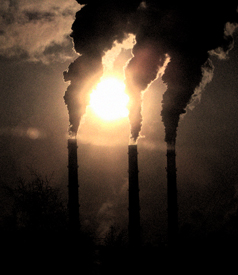Meet the Toxic 100 Corporate Air Polluters
Wednesday 31 March 2010

(Photo: otodo; Edited: Lance Page / t r u t h o u t)
Amherst, MA - Researchers at the Political Economy Research Institute (PERI) at the University of Massachusetts Amherst today released the Toxic 100 Air Polluters, an updated list of the top corporate air polluters in the United States.
"The Toxic 100 Air Polluters informs consumers and shareholders which large corporations release the most toxic pollutants into our air," said Professor James Boyce, co-director of PERI's Corporate Toxics Information Project. "We assess not just how many pounds of pollutants are released, but which are the most toxic and how many people are at risk. People have a right to know about toxic hazards to which they are exposed. Legislators need to understand the effects of pollution on their constituents."
The Toxic 100 Air Polluters index is based on air releases of hundreds of chemicals from industrial facilities across the United States. The rankings take into account not only the quantity of releases, but also the toxicity of chemicals, transport factors such as prevailing winds and height of smokestacks, and the number of people exposed.
The top five air polluters among large corporations are the Bayer Group, ExxonMobil, Sunoco, DuPont, and Arcelor Mittal. The Toxic 100 Air Polluters rankings have been expanded to include large privately held firms, such as number 10 Koch Industries, as well as the world's largest publicly traded corporations.
For the first time, the Toxic 100 Air Polluters includes information on the disproportionate risk burden from industrial air toxics for minorities and low-income communities. This makes it possible to compare corporations and facilities in terms of their environmental justice performance as well as overall pollution. For example, the data reveal that minorities bear 65% of the air toxics risk from facilities owned by ExxonMobil, while minorities make up 38% of the U.S. population.
Users of the web-based Toxic 100 Air Polluters list can view the details behind each company's Toxic Score, including the names and locations of individual facilities owned by the corporation, the chemicals emitted by those facilities, and the share of the Toxic Score borne by minorities and people living below the poverty line. The new edition also provides access to this information on all firms operating in the United States, regardless of size. Several smaller firms rank as big air polluters, topped by the Marietta, Ohio, facility of the French-owned Eramet Group and Houston-based Quality Electric Steel Castings LP.
The data on chemical releases come from the U.S. Environmental Protection Agency's Toxics Release Inventory (TRI). The TRI is widely cited in press accounts that identify the top polluters in various localities. But reports based on TRI data alone have three limitations:
- Raw TRI data are reported in total pounds of chemicals, without taking into account differences in toxicity. Pound-for-pound, some chemicals are up to ten million times more hazardous than others.
- TRI data do not consider the numbers of people affected by toxic releases--for example, the difference between facilities upwind from densely-populated urban areas and those located far from population centers.
- TRI data are reported on a facility-by-facility basis, without combining plants owned by one corporation to get a picture of overall corporate performance.
The Toxic 100 Air Polluters index tackles all three problems by using the 2006 Risk-Screening Environmental Indicators (RSEI) data, the most recent available from the EPA. In addition to TRI data, RSEI includes toxicity weights and population exposure. PERI researchers added up facility-by-facility RSEI data released by the EPA to construct corporate rankings.
"In making this information available, we are building on the achievements of the right-to-know movement," explains Professor Michael Ash, co-Director of the Corporate Toxics Information Project. "Our goal is to engender public participation in environmental decision-making, and to help residents translate the right to know into the right to clean air."
------
The Toxic 100 Air Polluters
The Toxic 100 Air Polluters index identifies the top U.S. air polluters among the world's largest corporations. The index relies on the U.S. Environmental Protection Agency's Risk Screening Environmental Indicators (RSEI), which assesses the chronic human health risk from industrial toxic releases. The underlying data for RSEI is the EPA’s Toxics Release Inventory (TRI), in which facilities across the U.S. report their releases of toxic chemicals. In addition to the amount of toxic chemicals released, RSEI also includes the degree of toxicity and population exposure. The Toxic 100 Air Polluters ranks corporations based on the chronic human health risk from all of their U.S. polluting facilities.
For further information, contact Professor Michael Ash or Professor James K. Boyce at +1 (413) 577-0816 or peri@peri.umass.edu or visit PERI's Corporate Toxic Information Project on the web at http://toxic100.org.
All republished content that appears on Truthout has been obtained by permission or license.
Let The Sun Shine In......




No comments:
Post a Comment
We post comments in English and only by followers of this blog. While anyone is free to read any of the material here, comments from self-identified, moderate to left-of-center independents are welcome to post after joining up. Others may comment by email and will occasionally be posted as well.